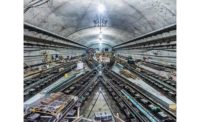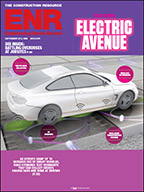Beneath Second Avenue on Manhattan�s Upper East Side, a 485-ton monster is chewing its way through bedrock, mining tunnels for New York City�s first new subway line in 50 years.
When completed in 2016, the Second Avenue line will run from 96th to 63rd Streets, where it will hook up with the existing 63rd Street and Broadway lines. Three new stations will be built at 96th, 86th and 72nd Streets along with new entrances to the existing Lexington Avenue/63rd Street Station.
The $4.45 billion project is the first phase of the Metropolitan Transit Authority�s multi-phase plan for the Second Avenue Subway. Subsequent phases will extend the line north to 125th Street and south to Hanover Square in lower Manhattan.
The line is expected to carry 213,000 riders each day, improving mass transit access for Manhattan�s Upper East Side and reducing overcrowding and delays on the Lexington Avenue line. Crowding on the Lexington Avenue line is projected to decrease 13 percent with travel times reduced by up to 10 minutes.
The MTA awarded the project�s first contract, valued at $350 million, to S3 Tunnel Constructors, a joint venture of Skanska USA Civil, Whitestone, N.Y., Schiavone Construction, Secaucus, N.J., and J.F. Shea Constructors, Walnut, Calif. A joint venture between AECOM, Los Angeles, and ARUP, New York designed the project.
The contract encompasses the construction of two tunnels between 92nd and 63rd Streets, excavation of the launch box for the tunnel boring machine (TBM) and access shafts at 69th and 72nd Streets. Work started in April 2007 and is expected to be completed in November 2011.
Preliminary designs for the project, done in the 1970�s, called for more cut-and-cover excavation than tunnel boring. The current project minimizes surface impacts to the public and commercial establishments along the route by going as much as possible underground, explains Geoffrey Fosbrook, senior vice president and project director, AECOM.
Using a TBM to mine the tunnels required construction of a launch box. The launch box, measuring 815-ft. long by 63-ft. wide and 56-ft. deep, extends beneath Second Avenue from 96th Street to south of 92nd Street and provides space for assembling and launching the TBM along with managing the debris excavated from the tunneling operation.
Prior to excavation of the launch box, the extensive network of underground utilities at the site were relocated. �I do not think I have ever seen a street so full of utilities,� says David Caiden, principal at ARUP.
Slurry walls and secant pile walls were built to reinforce the perimeter of the launch box. The slurry walls constructed in the northern half of the launch box are permanent walls that will be incorporated into the 96th Street Station, explains William Goodrich, program executive, MTA Capital Construction.
The cut-and-cover excavation of the launch box started in June 2009. A combination of controlled blasting and mechanical means removed 117,000 cubic yards of rock and soil.
Concrete decking installed over the excavation area allows traffic to utilize Second Avenue during construction. Two levels of lateral steel braces support the walls of the launch box. A mud matt forms the floor of the box.
During construction, preserving sidewalk and street access to businesses along Second Avenue restricted the size of work areas. �Working in such a tight area while maintaining traffic and pedestrians flow through the area was very challenging,� explains Mike Attardo, senior vice president with Skanska USA Civil.
Blasting took place in close proximity to the buildings lining Second Avenue. Sophisticated instrumentation and monitoring systems continuously monitor the building facades adjacent to the launch box and the launch box construction.
�The building stock in the area is a lot of brick masonry buildings that were built in the late 1800s to early 1900s,� Goodrich says. �Even without our construction it�s pretty fragile, and very sensitive ground induced settlement or vibrations. It�s been a challenge and we worked very hard to do this heavy civil construction in close proximity to the sensitive buildings without damaging them.�
Noise mitigation efforts are employed to reduce the disturbance to the community and include a prohibition on working in the street between 10pm and 7am in the morning.
Tunnel Boring
The TBM was delivered to the launch box in pieces starting in April after undergoing rehabilitation at Schiavone�s shop in Newark, N.J. Rehabilitation work essentially replaced all the mechanical and hydraulic components to as new conditions, explains Paul Scagnelli, Schiavone�s executive vice president and chief engineer.
Pieces of the TBM, the largest weighing over 120 tons, were lowered through an opening in the decking to the floor of the launch box for assembly. When assembled the TBM weighs 485 tons and is 450-ft long, including its trailing gear.
On the front of the TBM is a 22-ft. diameter cutterhead with 44-disc cutters. During operation the cutterhead turns while six hydraulic cylinders push the disc cutters against the rock face, making concentric pats. The force of the thrusting discs against the rock makes cracks, fracturing the rock face. �When the cracks join, slivers of rock fall out of the rock face,� explains Julio Martinez, tunneling manager for Schiavone Construction.
The TBM is held in place during the thrusting operation by curved gripper shoes that press against the side of the cylindrical tunnel walls and push the front of the system forward, Scagnelli explains. �After you push ahead six-feet or so there is an alternative support on the machine that supports it vertically so you can retract the side gripper shoes and then pull the machine ahead. �It is sort of like a caterpillar making its own hole.�
div id="articleExtras"





Post a comment to this article
Report Abusive Comment